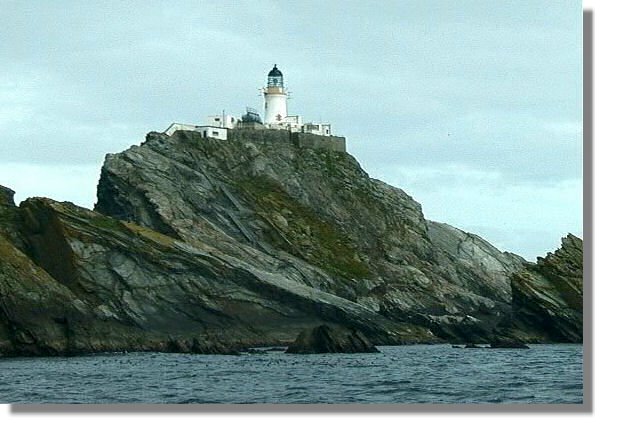

Lighthouse Beacons from Scotland
Muckle Flugga Lighthouse

Photo of Muckle Flugga Lighthouse by Tom McMahon
Muckle Fugga is the northern-most lighthouse in the UK being off the north tip the island of Unst in Shetland (It was called Unst Lighthouse until 1964). It is also one of the most famous. The building of this station was a difficult undertaking. The engineer was David Stevenson. After much struggle the light was operating for the first time in January 1858. The only access to this light is by boat. The photo on the right of the lighthouse, Muckle flugga and the Rumblings is by Mike Pennington
Although the creation of a lighthouse at Muckle Flugga was considered by the Lighthouse Commissioners in 1851, no work had been undertaken by 1854 due to difficulties in determining the exact site for the Lighthouse. Then, during the Crimean War, the Government pushed for a light there to protect Royal Navy ships. A temporary light was therefore established and was first operating on 11 October 1854. The temporary lighthouse building is said to have been completed in 26 days.
As the lighthouse was 50ft in height, on a rock 200ft above sea level it was thought that it would have to withstand only the wind and the rain. However, when the winter gales began to break over the rock it was found that the sea not only broke heavily on the tower, but ran up the sides and burst open the door of the lighthouse keepers' accommodation, knocking down 40ft of stone dyke in the process. This proved the necessity of raising the lightroom of the permanent tower so that the possibility of the seas endangering the light would be prevented.
Orders to proceed with the work were given in June 1855. A 64 foot high brick tower was built, with foundations sunk ten feet into the rock, and a permanent light appeared on 1 January 1858 at a total cost of £32,000 - high for these days.
Over the succeeding years, the seas sometimes broke over the rocks for 21 hours continuously, sweeping away one gate pillar and dislodging another, and blocks of stone 2ft square were rushed over the court as if they had been wood. The photo on the left of the lighthouse is by Mike Pennington.
The original steady, fixed lights were later regarded as unsuitable and in 1927/28 the character of the light was changed to group flashing.
In 1968/69 a new dwelling block was built within the retaining wall, in space saved by electrification of the power supply, replacing the primitive conditions which were described as "lightkeepers slept in a crows nest and ate in a cell".
There were three Lightkeepers on the rock at any one time; each of the six Lightkeepers manning the station spending one month on and one month ashore. The Lightkeepers were relieved by helicopter once they became available. Reliefs were sometimes long overdue because of heavy seas which made a landing from the Attending Boat impossible.
Robert Louis Stevenson, who was born in 1850, visited Muckle Flugga on 18 June 1869 with his father, Thomas Stevenson, Engineer to the Board and there is a suggestion that the Island of Unst influenced him in his writing of "Treasure Island".
Muckle Flugga Lighthouse was automated in March 1995.
Return to Index of Lighthouse Beacons from Scotland



